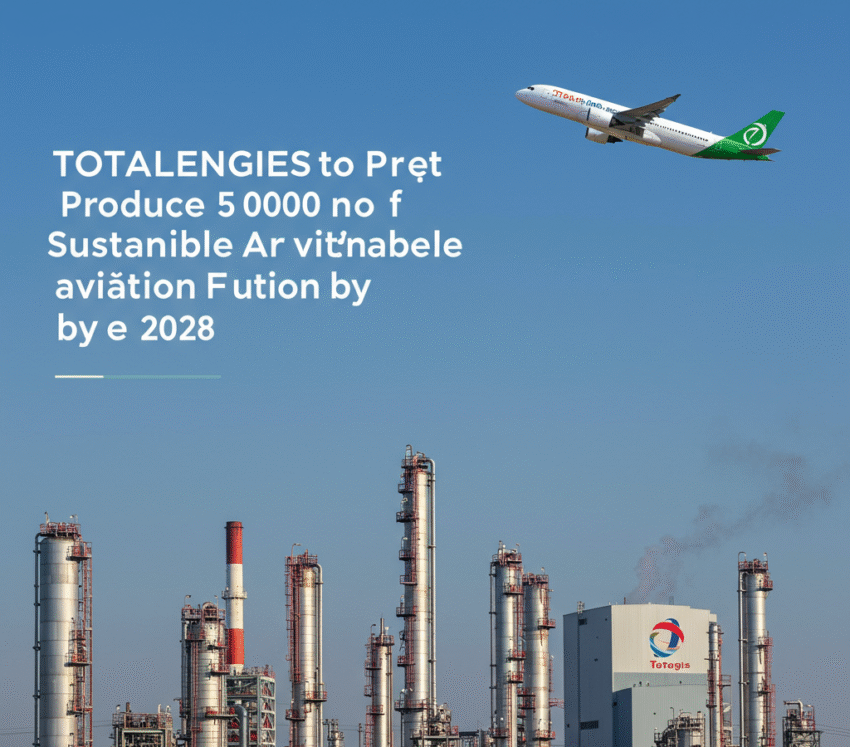Why TotalEnergies Is Betting Big on Sustainable Aviation Fuel by 2028
Flying Toward a Greener Future
Have you ever thought about how much fuel an airplane uses? It’s a lot. Now imagine trying to make that fuel cleaner and better for the planet. That’s exactly what TotalEnergies is doing. The company has just announced a big push into sustainable aviation fuel (SAF), with a goal to produce 500,000 tons of it each year by 2028.
But why all the buzz around SAF? And how does this move fit into the bigger picture of cleaner energy and eco-friendly travel? Let’s break it all down in simple terms.
What Is Sustainable Aviation Fuel (SAF)?
Sustainable aviation fuel isn’t some science fiction dream. It’s real—and increasingly popular.
Basically, SAF is jet fuel made from renewable sources instead of fossil fuels. It can come from things like:
– Used cooking oil
– Animal fats
– Biomass (like crop waste)
– Even industrial CO₂ converted into fuel
It works just like traditional jet fuel but with one big bonus—it produces way fewer carbon emissions. That’s a game-changer for airlines trying to reduce their environmental impact.
TotalEnergies’ Big Announcement
TotalEnergies, known for its roots in oil and gas, is steering toward greener pastures—literally. The company recently shared its plan to ramp up SAF production in a big way. Here’s a simple breakdown of what they’re aiming for:
| Goal | Details |
|---|---|
| Annual SAF Production by 2028 | 500,000 tons |
| Number of Facilities | 5 (located in France) |
| Main Feedstocks | Used cooking oil, animal fats, low-carbon feedstocks |
| Technology Used | HEFA Process (Hydroprocessed Esters and Fatty Acids) |
So, why does this matter? Because aviation is responsible for about 2-3% of global CO₂ emissions. By replacing even a portion of conventional fuel with SAF, the industry can take a big step in the right direction.
France Takes the Lead in SAF
It’s worth noting that France is raising the bar when it comes to eco-friendly initiatives. Starting in 2022, airlines in France were required to use at least 1% SAF in their fuel mix. That number is expected to rise to 2% by 2025 and 5% by 2030.
TotalEnergies is clearly gearing up to meet that demand—not just in France, but globally.
Why Is This a Big Deal?
Let’s put it this way: reaching 500,000 tons of SAF production is like planting millions of trees. It’s a concrete step toward lowering the aviation industry’s carbon footprint.
Here are a few reasons TotalEnergies’ plan stands out:
– 🛫 It supports global airline sustainability goals.
– ♻️ It turns waste like used cooking oil into useful fuel.
– 🌍 It helps countries meet their climate commitments under the Paris Agreement.
– 💼 It creates green jobs in fuel production and research.
In a world where climate change headlines are all too common, this kind of move gives us a bit of hope.
Wait, Isn’t SAF More Expensive?
Yes, it’s true—SAF currently costs more than regular jet fuel. But it’s all about scaling up.
Right now, SAF makes up less than 0.1% of total aviation fuel used globally. That tiny market share means production is limited and prices are high. But as more companies like TotalEnergies invest in SAF, those costs can come down.
Think of it like solar panels. Twenty years ago, they were super expensive. Today, they’re affordable and everywhere.
Challenges Along the Way
Of course, it’s not all smooth flying. There are real obstacles to overcome:
1. Feedstock Supply: The raw materials, like used cooking oil or animal fats, are limited. That means TotalEnergies needs to secure reliable sources to keep production going.
2. Infrastructure: SAF still isn’t widely available at airports. You can’t just pull up to a jet fuel pump that has SAF on tap—yet.
3. Regulations: Different countries have different rules about SAF. Some offer subsidies and incentives. Others are still figuring things out. Harmonizing these policies would help SAF take off faster.
So, What’s Next?
TotalEnergies isn’t alone. Big airline players like United Airlines, Delta, and Lufthansa are also investing heavily in SAF. Everyone’s trying to hit net-zero goals by 2050—and SAF is one important piece of the puzzle.
Even Boeing and Airbus are working on aircraft that are SAF-ready.
And while some travelers (maybe even you?) are starting to think about their “carbon footprint” when booking flights, the airlines themselves look to initiatives like this one from TotalEnergies to make flying more sustainable.
What Can You Do as a Traveler?
You might be wondering, “How can I make a difference?”
Here are a few ideas:
– ✈️ Choose flights or airlines that prioritize SAF.
– 🌱 Offset your carbon emissions using aviation calculators.
– 💬 Talk about SAF with friends and family. Awareness matters.
– 🧳 Pack light—a lighter plane uses less fuel!
Small steps can lead to big change—especially if more people get involved.
Final Thoughts: A Greener Sky Is Possible
Let’s be real—air travel isn’t going away. It connects people, cultures, and ideas. But that doesn’t mean we can’t make it cleaner.
With companies like TotalEnergies stepping up to the plate, there’s hope for a brighter, greener future in aviation. Their goal of producing 500,000 tons of sustainable aviation fuel by 2028 shows that progress is not just possible—it’s already happening.
So the next time you hear a jet overhead, think about this: we’re getting closer to a world where flying doesn’t have to cost the Earth.
Because the sky’s the limit—but our planet isn’t.
SEO Keywords Used:
– Sustainable aviation fuel
– TotalEnergies SAF production
– Clean jet fuel
– Renewable aviation fuel
– Green energy aviation
– Eco-friendly travel
– Aviation fuel emissions
– Future of flying
Thanks for reading! Want more bite-sized updates on green innovations? Stick around—we’ve got more coming soon. 🌍✈️
